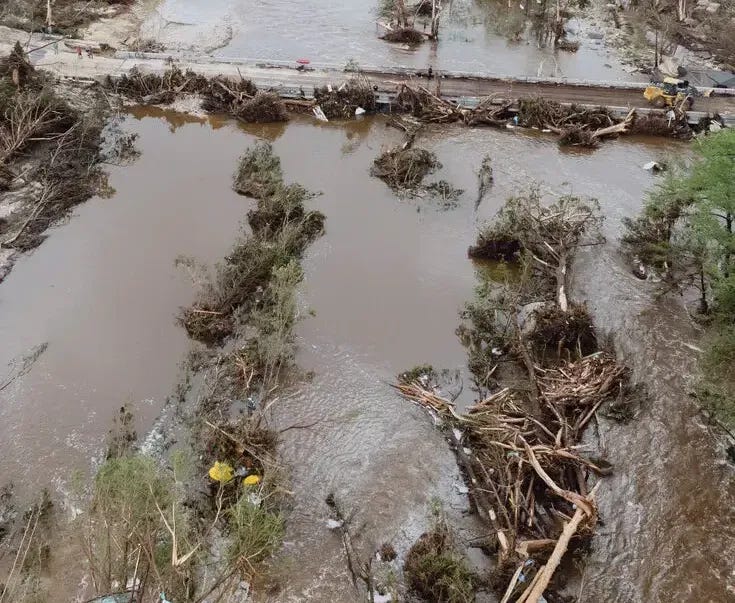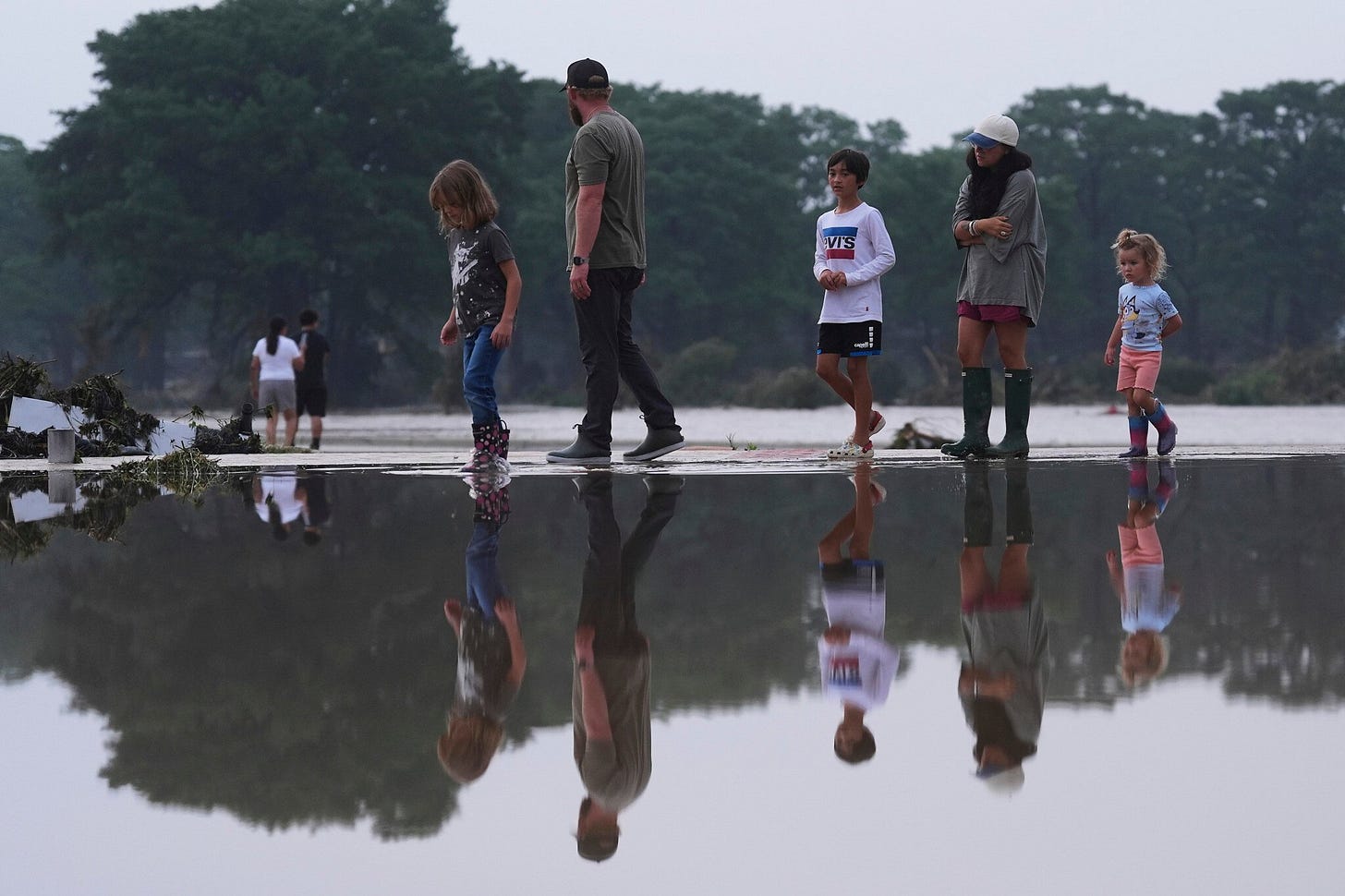On July 4th, a deadly flood swept through parts of Texas Hill Country killing, at the time of writing this, 32 people and displacing hundreds more. Entire homes were torn from their foundations, RV parks were submerged, and residents were left screaming for help from their vehicles as rivers turned into torrents. Survivors have described scenes of chaos, fear, and confusion. This has quickly become a tragedy earmarked by hours-long delays in public warnings and a pattern of underinvestment in basic emergency infrastructure.
This disaster was made worse by federal cuts to the very agency tasked with monitoring and predicting these disasters. Under the Trump administration, the National Weather Service (NWS) has undergone significant defunding and hiring freezes, reducing its capacity to issue and coordinate real-time warnings. Rather than improve forecasting tools officials in Trump’s orbit have chosen to continue to cut programs and services that benefit everyone in The United States. In the hours after the initial flooding, some Texas officials deflected blame onto the NWS, claiming forecasts were “inaccurate.” These comments from state officials come despite the NWS issuing accurate rainfall projections and flood risks well in advance of the disaster. In reality, the NWS predicted 4 to 8 inches of rain in areas that typically see 30 inches in a year. It was not a failure of forecasting like government officials want to claim. It was a failure to listen.
According to the National Weather Service, a flood warning was issued for Kerr County at 1:14 p.m. Despite this fact, county officials did not respond publicly until more than four hours later. At 5:16 p.m., local police advised people near the Guadalupe River to seek higher ground, and the county itself didn’t issue an official notice until 7:32 p.m. By that time, water levels had already risen catastrophically.
Since Kerr county lacks the ability to send push alerts or county-wide emergency notifications, local officials resorted to posting updates on Facebook, a platform that does not notify residents unless they are actively checking their feed. This is of course assuming you’re one of the people who still uses Facebook. It is also important to acknowledge that these alerts were sent out early in the morning while people were likely sleep. For families living in low-lying areas, especially RV parks and mobile home communities, these delays and oversights were deadly.
A Pattern of Repeated Systemic Neglect is to Blame
The failures of Kerr County officials are part of a broader pattern of systemic neglect in Texas. Normally county governments are responsible for establishing emergency management protocols, flood alert systems, and evacuation infrastructure. Kerr County has no dedicated flood warning system. It can not be stressed enough, The Guadalupe River has a well-documented history of deadly flooding with the most recent flood occurring in 1987. This is a region that averages just 30 inches of rain per year, receiving 4 to 8 inches in a single event should have triggered immediate, aggressive warnings. Instead, lives were lost.
This lack of preparation is tragically consistent with how the state has responded to other emergencies. During the 2021 winter storm, Texas’s power grid collapsed under the strain of freezing temperatures, leaving over 10 million people without electricity and killing more than 240. Dozens died of hypothermia in their own homes. Pipes burst. Water treatment systems failed. The Electric Reliability Council of Texas (ERCOT) had ignored recommendations for winterization for over a decade prior to the disaster. Four years later, it is clear those lessons went unlearned. Once again, Texas communities are facing the deadly consequences of state and local governments failing to act on well-known risks.
In Medina County, just south of Kerrville, deputies were forced to go door to door evacuating residents in rising waters. In other towns, entire RV parks were swept away. According to eyewitness accounts documented by the Houston Chronicle, Newsweek, and The Guardian, residents saw loved ones trapped inside cars, homes lifted from the ground, and neighbors swept downstream while awaiting evacuation orders that came too late.The humanitarian impact is staggering, but the underlying causes and problems are structural.
Climate change is making extreme weather more frequent and more intense in Texas. Sudden bursts of heavy rain, once rare, are becoming common. Despite this fact public officials remain underprepared and, in some cases, openly hostile to climate science and the public agencies that issue the warnings.From the winter blackout of 2021 to this summer’s floods, Texas has shown again and again what happens when leadership ignores warnings and refuses to prepare.
Texas has the resources to do better. It is the 8th largest economy in the world by GDP, it is despite this that the state leadership continues to underinvest in public infrastructure, hollow out emergency systems, and treat science with hostility. Warnings are politicized. Climate risks are downplayed. The people left the most vulnerable—elderly residents, poor families, immigrants—are left to face disaster alone. Texas has the technical ability to create sophisticated alert systems, harden infrastructure, and prepare for climate-driven risks. It actively chooses not do so. The cost is paid in lives, in grief, and in shattered communities. Unless that changes, this deadly cycle will continue to repeat again and again. As Texans continue to sift through the wreckage, the accountability questions grow louder. How many lives could have been saved with proper alerts? How many could have been spared if national forecasting systems had the resources they need? Why are emergency warnings being delegated to social media pages rather than emergency broadcast systems?
Sources
The Daily Beast. “Texas Officials Slam Donald Trump’s National Weather Service for Bad Forecast.” The Daily Beast, 4 July 2025. https://www.thedailybeast.com/texas-officials-slam-donald-trumps-national-weather-service-for-bad-forecast
Newsweek. “RV Park Swept Away in Texas Floods.” Newsweek, 4 July 2025. https://www.newsweek.com/rv-park-swept-away-video-texas-floods-2094803
KSAT. “Deputies Went Door to Door to Evacuate RV Park Residents.” KSAT San Antonio, 4 July 2025. https://www.ksat.com/news/local/2025/07/04/deputies-went-door-to-door-to-evacuate-residents-from-rv-park-due-to-rising-medina-river/
The Guardian. “Texas Flood: Survivors Recall Pleas for Help as Homes Were Swept Away.” The Guardian, 4 July 2025. https://www.theguardian.com/us-news/2025/jul/05/texas-flood-survival-pleas-for-help-missing
Houston Chronicle. “Survivors of Texas Floods Witnessed Homes Swept Away, People Trapped in Cars.” Houston Chronicle, 4 July 2025. https://www.houstonchronicle.com/news/houston-texas/trending/article/texas-flood-survivors-say-warnings-evacuate-came-20463844.php
National Weather Service. “Flash Flooding and Dam Break in the Hill Country – July 17, 1987.” National Weather Service Austin/San Antonio TX, https://www.weather.gov/ewx/wxevent-19870717.













